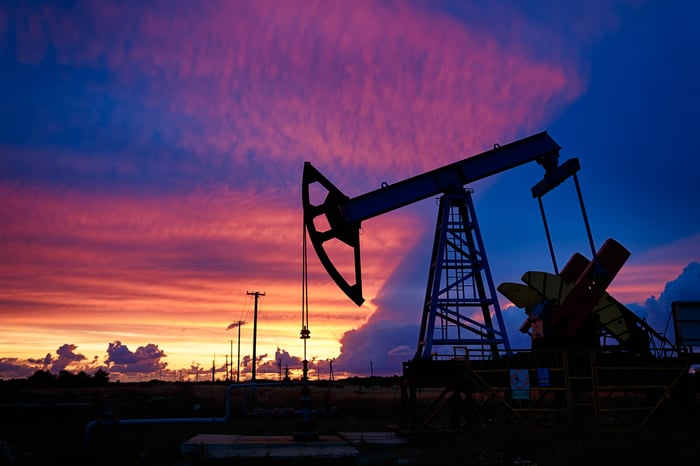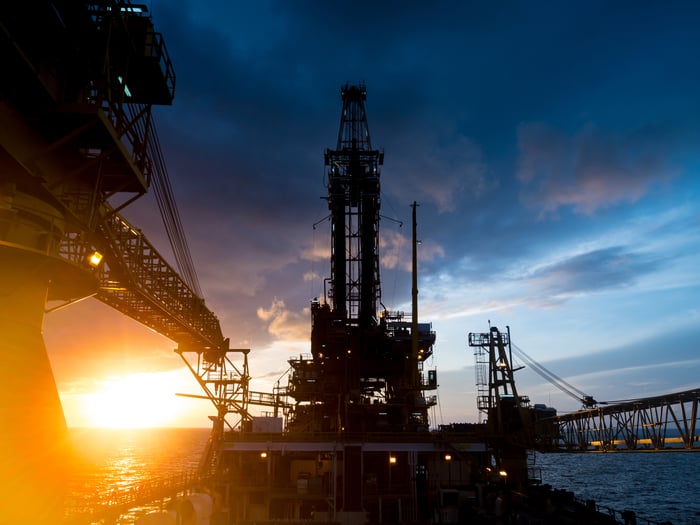ConocoPhillips (COP 1.32%) has worked hard to differentiate itself from other oil companies by focusing on creating value for investors as opposed to growing at all costs. That plan continued paying dividends during the first quarter, as the company blew past expectations. That strong showing sets the U.S. oil giant up for an exceptional year.
Drilling down into the quarter
Heading into the first quarter, analysts anticipated that ConocoPhillips would earn $0.67 per share. The company, meanwhile, thought that production would come in between 1.18 million to 1.22 million barrels of oil equivalent per day (BOE/D). The oil titan, however, beat both numbers with ease.

Image source: Getty Images.
Production topped the high end of the forecast at 1.224 million BOE/D. That was 4% higher than the year-ago period after adjusting for asset sales. It was up an even more impressive 26% on a debt-adjusted share basis, which factors in the impact of the company's share repurchases and debt retirements. Fueling the better-than-expected production was ConocoPhillips' big three unconventional assets: Bakken shale, Eagle Ford shale, and Delaware Basin. Overall, the output from those three regions jumped 20% year over year.
That high-end result, when combined with higher oil prices and lower costs, helped drive earnings well above expectations. The company earned an adjusted $1.1 billion, or $0.96 per share, which was a substantial improvement from the year-ago quarter, when it posted an adjusted loss of $0.2 billion, or $0.14 per share.
Cash flow from operations was even stronger at $2.5 billion. ConocoPhillips used that money, plus some cash from its balance sheet, to invest $1.5 billion in drilling new wells, buy back $500 million of shares, pay about $300 million in dividends, and retire $2.9 billion of debt. The company ended the quarter with $5 billion in cash and $17 billion in debt, putting it within striking distance of its goal to get debt down to $15 billion by the end of next year.

Image source: Getty Images.
What's ahead for ConocoPhillips?
Thanks to that strong start, ConocoPhillips now believes full-year production will come in between 1.2 million and 1.24 million BOE/D. That's an improvement from its initial guidance range of 1.195 million to 1.235 million BOE/D, which represented a 5% increase from 2017. What makes that forecast even more impressive is that ConocoPhillips now expects a third-party pipeline outage in Malaysia to last all year, keeping its KBB field offline in 2018. The company also made no changes to its plan to invest $5.5 billion into capital projects, meaning that the main driver of its anticipated outperformance in 2018 will be stronger well performance.
The oil giant also said that it still expects to repurchase a total of $2 billion in shares this year, which matches its initial estimate. This buyback has already proven to be a boon for shareholders since the company initiated it in September 2016. Overall, the stock is up 50% since that time versus 22% for the S&P 500 and just 4% for the average energy stock.
It's worth noting that ConocoPhillips based its current three-year operating plan on oil averaging $50 a barrel. With crude now well above that level at nearly $70 a barrel, the company is on pace to generate significant excess cash. As a result, it could retire more debt than currently planned or boost the share repurchase program that already has it on pace to buy back $7.5 billion in stock by the end of 2020.
A great start to what looks like an exceptional year
ConocoPhillips' first-quarter results show that its strategy to create value for investors is working. The centerpiece of that plan is a focused investment approach to grow its highest-return assets, instead of pouring all its money into just increasing production, which is the aim of some rivals. By taking a different route, the company is generating ample excess cash, which has given it the money to create additional value for investors by retiring debt, buying back stock, and increasing its dividend. This strategy appears as if it will continue paying off for investors in the coming years, especially since crude prices are well above the level ConocoPhillips needs to make its plan work.




